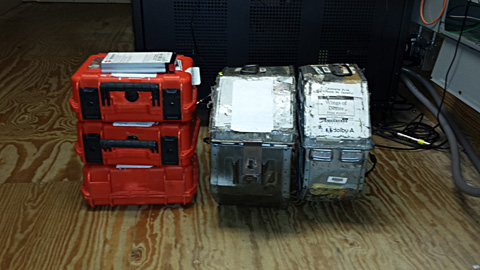
SIZE MATTERS The three plastic cases on the left each contain a digital feature film. The two metal
cans on the right together hold a single feature-length film (one can with four reels and the other with
three). A hard drive is atop the left pile for scale. ‘Our UPS driver loves that we’ve converted to digital,’
says Railroad Square’s Alan Sanborn. |
The horror film regional drive-ins and arthouse cinemas have been dreading for the past five years would be best titled The Reckoning. In it, a shadowy cabal of film distributors and studios announce that they will cease distributing bulky, analog, 35-millimeter film prints at some vague but impending point in time. With as little as a few days’ notice, prints fail to show up at a theater’s doorstep, forcing schedule changes, audience dissatisfaction, and a palpable hit to the weekend’s expected business. The only way out of the impasse is to pony up, at minimum, $50,000 to upgrade to a digital projection system.
“It’s been an absolute nightmare,” says Ry Russell, manager of the Saco Drive-In, of a tense summer. “Typically what we’ve been able to do was submit a request for what the movies were that we wanted to play, and three days before they showed up at the door. This year we were putting in requests months in advance, and two to three days before, nothing shows up. They just release such a small quantity of each movie on film, and they’d send them to the theaters where they’d make the most money.”
Russell’s experience booking summer tentpoles was similar to that of arthouse proprietor Barry Norman, who runs the great Eveningstar Cinema in Brunswick. “As 35mm is being eliminated by the end of this year, it was getting harder to get film prints as distributors, especially the smaller ones, made less and less prints. Often, I couldn’t get a print due to the reduction in the number made and where Brunswick, Maine would be on the ladder,” he says.
Both theaters have had to deal with undesirable circumstances over the past year, being forced to hold over certain films regardless of their popularity. As Russell put it, “Honestly, what we ended up doing was picking crappier movies . . . We literally had to pick up junk movies in order to get that turn that we wanted. Getting a junk movie was probably 2.5 percent better than playing a movie we already played.”
The good news is that, for most Maine arthouses and drive-ins, this scary movie seems to be ending well: the Saco Drive-In was the only theater in New England to win a Honda-sponsored contest to provide drive-ins with free digital upgrades; in the immediate area, only Westbrook’s Prides Corner Drive-In has yet to announce concrete plans for a digital upgrade, and owner Andrew Tevanian will be seeking a bank loan to assist the transition. In April, the Eveningstar borrowed money to pay a reported $55,000 for a digital projection system; just last month Russell finished raising $46,000 in a crowdfunding campaign to help cover that debt.